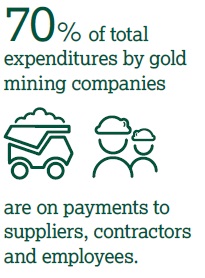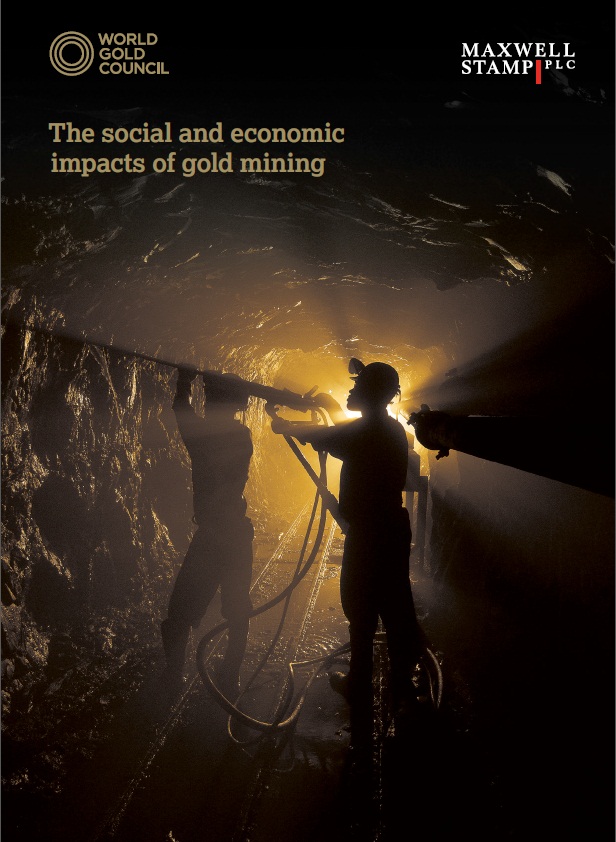The social and economic impacts of gold mining
Despite the industry’s scale, the socio-economic impacts of the gold mining industry are not well understood.
Gold mining companies are a major source of income and economic growth, with an important role in supporting sustainable socio-economic development. During 2013, gold mining companies contributed over US$171.6bn to the global economy through their production activities and expenditure on goods and services. This is more than the combined gross domestic product of Ecuador, Ghana and Tanzania, or close to half of the gross domestic product of countries such as South Africa or Denmark.
Whilst the potential for negative social and environmental impacts from gold mining activities is well known, the nature and distribution of the socio-economic impacts of gold mining at an industry level on host nations and communities is relatively poorly understood. Focusing on the impacts of large-scale commercial gold mining, this report builds on previous studies commissioned by the World Gold Council to provide an understanding of the socio-economic impacts of the gold mining industry at a global, national and host community level. In doing so, this report seeks to facilitate more effective dialogue between companies, governments, citizens and civil society and contribute towards the development of policies and engagement activities that deliver shared value for all stakeholders.
The value created by the gold mining industry is becoming increasingly important for the socio-economic development of nations and communities
Responsibly undertaken, gold mining has the potential to make a significant, positive impact on the economies of the countries in which gold mining takes place and on the lives of the citizens of those countries. Amongst the top 30 gold producing countries, over 60% are low or lower-middle income countries with substantial socio-economic development needs. In eight of the top 30 gold producing countries, the production and procurement activities of gold mining companies generate over 10% of each country’s gross domestic product. For two of these countries, this figure rises to over 25% of gross domestic product.
Many of the countries that are significant gold producers are also impoverished countries that are long term recipients of development assistance (aid) from foreign government donors. Given that reliance on foreign aid is an inherently vulnerable position for any impoverished country, it is notable that the economic value directly and indirectly created by the gold mining industry globally has exceeded the global total value of development assistance every year since 2010.
Perhaps more importantly, given cuts to aid budgets in many donor countries, the longer term trend for the economic value created by the gold mining industry is that of significant growth. The direct economic contribution of the gold mining industry to the global economy, as defined by ‘gross value added’ (GVA), has increased almost seven-fold in the period from 2000 to 2013. The world regions that have benefited most from the growth in the value created by gold mining are Asia and Africa, which account for the largest shares of gold mining GVA. Amongst several of the lower income gold producing countries, such as Ghana and Mali, growth of the gold mining industry means that gold mining companies now create substantially more value in the economy than is received from development assistance programmes. For Ghana and Mali this was not the case as recently as 2008.
The economies of gold producing countries gain far more value from the productive activities of gold mining companies than they do from royalties on land use
Naturally, governments of gold producing countries want to maximise the value that they receive from the mining companies that develop their resources. Much of the literature on this topic suggests that royalty rates on mineral extraction are the principal economic benefit for governments. However, an analysis of gold mining company expenditures reveals that far more value is distributed to host governments and the wider economy through other means. By far the most significant means by which value flows from gold mining companies to the economies of host countries is through payments to suppliers and contractors and wages for employees. Together these two areas, usually taxed by governments, account for 70% of total expenditures by gold mining companies. In terms of direct taxation, almost 60% of the payments that gold mining companies make to host governments are for income and corporate taxes. Royalty rates, by contrast, account for around 15% on average of direct taxation. Other taxes that can be almost as significant as royalty payments include import or fuel duties – for some mining companies fuel costs may account for up to 40% of total operating expenses, so such duties can be significant.
To download the full report, please click here.

